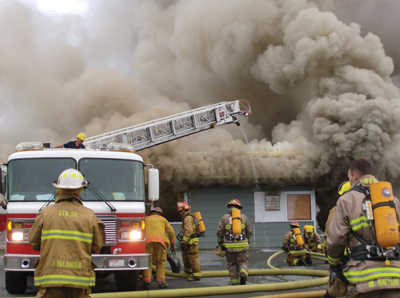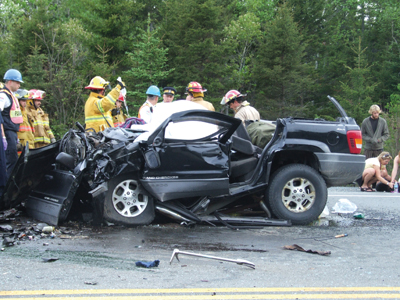
News
Recruitment trends
CURRENT ISSUE
Recruitment trends
Composite departments in western Canada struggle to fill vacancies.
March 27, 2009
By Paul Dixon
Canada’s population is aging. The first wave of baby boomers has turned 60 and entered retirement. StatsCan noted in the 2006 census report that by 2016 there will not be enough new workers entering the job market to replace those leaving through retirement. What does this mean for Canadian fire services?
 |
|
| Career and volunteer members of Halifax Fire and Emergency Services rush to reposition lines so Quint 5, a career truck, can be moved as it becomes threatened by a fast-moving fire in a large industrial/commercial building on the outskirts of Halifax in August 2008. The chief officer at left is a volunteer.
Photo courtesy Halifax Fire and Emergency Services.
|
We opted to look at composite departments from coast to coast – of which there are just over 200, according to the Canadian Association of Fire Chiefs – since we know many volunteer departments struggle with recruitment and retention and full-time departments have no trouble filling vacancies. Our informal survey of several composite agencies reveals a mixed response. Out west, in British Columbia and Alberta, there is at least anecdotal evidence of a deepening trend, while composite departments in central Canada and the Maritimes seem to be doing OK.
Dave Hodgins, managing director of Alberta’s Emergency Management Agency has heard enough complaints from around the province to initiate a formal survey on the question of recruitment but the data won’t be ready for some time.
In British Columbia, the Fire Services Liaison Group sent surveys on a wide range of issues including recruitment and retention to the province’s more than 350 community based fire departments. The liaison group is made up of the Union of B.C. Municipalities and five groups representing operational firefighting in B.C. – The Fire Chiefs’ Association of B.C., The Fire Prevention Officers Association of B.C., the Fire Training Officers Association of B.C., the B.C. professional Fire Fighters Association and the Volunteer Fire Fighters Association of B.C. The group is looking at potential new models for fire/rescue service systems. In its Dec. 1. draft report, of the 175 departments that responded to the survey, every agency that relies on volunteer or paid on-call fire fighters cites difficulty attracting and retaining members.
Over the past 20 years or so, many fire departments have become larger as a result of smaller municipalities amalgamating to form a single entity, either by choice or by decree of the provincial government. Halifax Regional Municipality and the City of Ottawa are two examples; the original cities formed the nucleus and adjoining smaller communities and rural areas were added to create the new mega-cities. The fire departments, as a result have career halls, composite halls in the outer suburbs and volunteer halls in the outlying rural regions.
Surrey, B.C., is evolving through a different model. Forty years ago, Surrey was considered a day trip from Vancouver – somewhere out in the sticks. The fire department had four career halls and 12 volunteer halls. Twenty years ago it was the largest composite department in Canada, with more than 300 paid on-call firefighters. Today, as the city’s population rapidly approaches a half million, and Surrey has become the geographical centre of metro Vancouver, there are fewer than 100 volunteer firefighters in two composite halls and two volunteer halls, augmenting the 13 full-career halls.
Deputy Chief Dan Barnscher acknowledges the dwindling reliance on volunteers. “We will still accept applications for paid on-call positions but we’re not actively recruiting for them.” Skill sets, equipment and apparatus have evolved as well. We all know there is much more to being a firefighter than fighting fires. This is reflected in the number of departments now known as fire rescue or fire and rescue. A retired B.C. chief recalls the process he took to become a paid on-call firefighter in his department. “Training was conducted by the career firefighters on shift at the time, generally three nights a month. It took about three years before you were fully qualified for interior attack and the like. You didn’t drive any department vehicles, even the pickup trucks. Only the career men drove the trucks. The selection process was by the other volunteers and not as it would be today, where the decision would be made by the chief based on competence. It was as much a popularity contest as anything. There was a long tradition of sons following fathers into the department as auxiliaries. It was important that you stayed around for a beer after practice, if you wanted to be voted in.”
When Wayne Williams joined Penticton Fire & Rescue as deputy chief nine years ago there was a waiting list for on-call firefighters. Today, as chief, he reports that he is unable to fill vacancies for on-call positions despite running recruiting drives twice a year. In Penticton, as in many other departments, career vacancies were filled from the ranks of the volunteers. Today, as many would-be firefighters are acquiring NFPA Level I & II accreditation before applying for a job, they are willing to travel further for employment. Williams has seen several of his on-call firefighters hired away by Vancouver, Surrey and Edmonton in the past two years.
 |
|
| Volunteer members from Halifax Regional Fire and Emergency Services from Hubbards, an adjoining county to Halifax, work to extricate the lone survivor of a head-on crash on Highway 103 outside of Halifax in June 2008. Photo courtesy Halifax Fire and Emergency Services. |
Bernie Turpin, administrative chief with Halifax Regional Fire & Emergency Service, says his department has a fairly constant turnover rate of about 10 per cent from year to year, but it’s also in a unique situation with lots of military personnel living in the region. “They are generally willing volunteers but they are subject to transfers every few years.”
Ottawa Fire Services has a 10 to 15 per cent annual turnover rate in its volunteer and on-call ranks. Gordon Mills, deputy chief (rural services), says that while family and relationship issues seem to be cited during exit interviews as reasons for leaving the fire service, Ottawa has created a powerful attraction by consistently drawing a significant portion of its new career hires from the volunteer ranks.
Training is even more important for all those other duties that have become part and parcel of the firefighter’s day as well as public expectation: road rescue/extrication; rope rescue; confined space rescue; hazardous materials; marine firefighting; wildland firefighting; swift-water rescue; ice rescue; urban search and rescue; and medical first response. Once the skills have been acquired and a minimal level of certification attained, that skill level must be maintained. It takes time and commitment.
Mills from Ottawa says, “keeping their time structured, productive and fun is the key. Instilling a sense of pride with station clothing, uniforms, proper gear and reliable equipment that they feel competent in operating, all contributes to building a team and instilling a sense of ownership.”
It takes many hours of drill and training to meet minimum standards for volunteer or auxiliary firefighters. Even those arriving with Level I & II require a structured introduction and orientation into the department. Over the past 20 years, occupational health and safety, workers compensation legislation and ultimately Bill C-45 have put the onus on the employer to be proactive in providing the right equipment and training to do the job and responsible supervision, along with appropriate documentation.
For paid on-call and volunteer firefighters, responses during working hours can place a strain on their employers as call volumes rise in growing communities, especially between nine and five, Monday through Friday. Dave Mitchell, former communications chief with Vancouver Fire & Rescue and now a consultant, has done call-volume surveys for communities demonstrating that the hours of peak demand for firefighter availability are also the hours of lowest availability. There is a critical mass of population, call volume and public expectations that ultimately sees a community completing the volunteer-composite-full career staffing model. There are tipping points along the way, tied to the ability of the community to finance the change to career from volunteer.
The fixed costs associated with maintaining a fire department will remain constant whether the agency is made up of volunteers, career firefighters or a combination. The costs of the building, apparatus and equipment are the same. The variable in the equation is the cost of the human factor. Volunteers or paid on-call firefighters represent a fraction of the costs associated with a full-time, career position no matter how the volunteers are remunerated – honorarium, stipend or pay per call. As budgets have tightened over the past decade, and with that belt tightening now exacerbated by the economic events of the past year, many communities may have reached the point at which they should move to full-time firefighters, at least for the Monday to Friday daytime hours, but they just can’t afford to do so.
Print this page